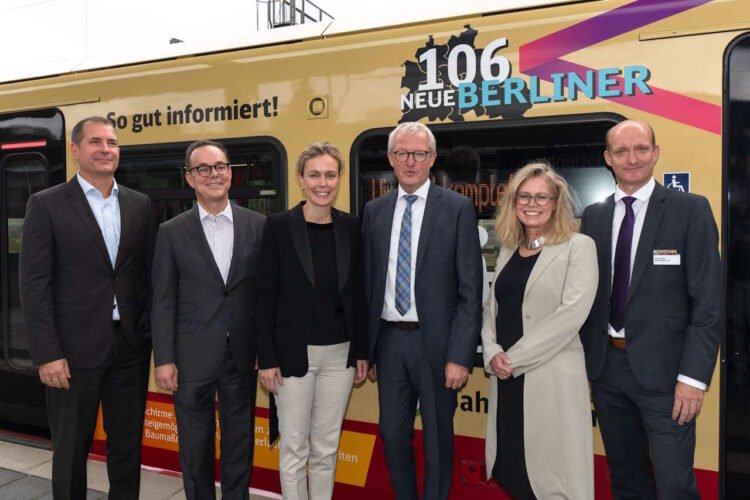After a delay which it blamed on supply chain problems, manufacturer Stadler has officially handed over the first test vehicle of next generation of yellow underground trains to Berliner Verkehrsbetriebe (BVG).
The official handover took place yesterday (Thursday 11 January) at the Olympia-Stadion underground station, and was attended by guests from politics, the public transport industry and the media. Guests took a close look at the inside and the outside of the new vehicle, which has the internal BVG series designation ‘JK’.
The vehicle has newly-designed door areas and flat passenger information systems on the side walls, which make it appear much more spacious than its predecessor. Other innovations include light colour controlled according to the time of day and position of the sun, and the ‘BVG Wi-Fi’, which will provide good Internet connections not only in stations but also on trains.
The handrails face outwards, which provides space in the passageways, benefiting wheelchair users and parents with pushchairs.
Before entering passenger service, the vehicles will complete a stringent programme of testing. Workshop specialists are familiarising themselves with the new vehicles, and training of the drivers for test and acceptance runs has begun.
Next, the vehicles will go onto the tracks, first on the premises of the Grunewald workshop, then on the entire small-profile network (lines U1 to U4). Once all tests are successfully completed, a twelve-week phase of test runs will take place, probably starting in late summer 2024, before entering passenger service.
Test findings may lead to adjustments to vehicle production.
Stadler believes that the new large-profile J and small-profile JK series trains will shape the image of the Berlin underground for decades to come.
This purchase is the largest procurement order in the history of BVG. The three-billion-euro framework agreement, awarded to Stadler in 2020, stipulates that up to around 1,500 vehicles can be delivered by 2035, with Stadler supplying spare parts for thirty-two years. The current delivery order is for 236 carriages of the J series and 140 carriages of the JK series.
The agreement also includes the delivery of twenty-four test vehicles, twelve each for small and large profiles.
Governing Mayor Kai Wegner said, “Today is a good day for BVG and a good day for Berlin. These new and modern trains will shape the image of the underground for decades to come – and thus also contribute to the mobility transition in Berlin. Our aim is that even more people switch to BVG and local public transport.”
Manja Schreiner, Senator for Urban Mobility, Transport, Climate Action and the Environment, said, “The mobility transition not only requires good infrastructure, it also requires modern vehicles. If we want to convince more and more people of the benefits of environmentally friendly mobility with buses and trains, then we also need to offer them attractive options.”
Henrik Falk, who took over as CEO of BVG at the turn of the year, said, “I am delighted that my return to BVG starts with this great news. It’s especially good news for our passengers, who can look forward to many improvements.”
Dr Rolf Erfurt, BVG Board Member for Operations, said, “Over the past 3.5 years, we have worked closely with Stadler in a difficult environment. I am therefore all the more pleased that we can now present the first underground vehicle. Over the next few months, our experts will be putting the trains through their paces. The quality should and must be right before the first passengers board.”

Jure Mikolčić, CEO of Stadler Germany, said, “Handing over a new underground train is always a great moment. All the more so when it’s a tailor-made product – like the trains for BVG. 4600 individual components have to fit together and work perfectly with each other as well as with the existing infrastructure. We are working with our fullest commitment to get the new fleet on the tracks.”






Responses